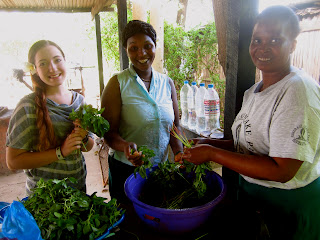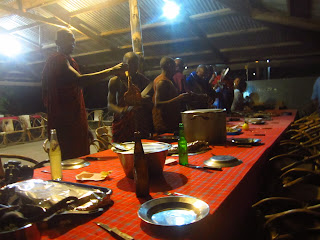Nandi, the Rhino!
Our first rhino monitoring session started at dawn. The three of us followed a young
Ugandan ranger named George; we gripped our toes tight inside of the hot gumboots
protecting us from the mud, and dreamed out loud about our nearing first
encounter.
We
rounded the corner to see Nandi, the matriarch of the reserve, with her
youngster Maliaka, and full with another one on the way. She was grazing nearly one hundred feet
away. Her body solid as steel, her
horns breathtaking, and her eyes soft, but there just above her left eye the
sun caught a foreign mark. She has
been wounded, badly. As the ranger
stepped closer he reprimanded the ranger just relieved from duty asking when
this happened. He didn’t
know. During the five-hour shift
we had that day sitting in the shade and following Nandi and Maliaka’s every
move, head rangers came to take pictures of the wound seeping blood and
accumulating maggots. The vet was
called instantly to come from Kampala, it was now this animal was in need of
human intervention for the possible infection could be fatal.
For
the next twenty-four hours the rumors and anxiety levels flew between the some
seventy rangers working day and night shifts, monitoring every rhino throughout
the sanctuary. The Executive
Director, Angie, a South African woman who is hard as nails prepared us as we
would be on the scene at the darting and tranquilizing of the three ton
animal. There was palpable worry
in her actions and tone, she had us resign our consent waivers and repeated
several times that our time working with the doctor and Nandi could be
extremely dangerous. “Why
exactly?” In order to inspect and
clean Nandi’s wound we would have to first dart her with a possibly lethal
injection, as the injection found its way to her blood she could do anything in
the ten minute window it takes for her to drop, this meant charging the
humans. After Nandi would fall we
would only have twenty minutes to clean her wound. The variables: falling on the wrong side in which case we
would have to roll her over, Maliaka’s need to be with her mother and her
possible charge or even worse the presence of other, larger rhino’s, charging
the scene. We strapped on our gumboots,
welcomed the most notable vet in Uganda to the farm and closed our mouths-ready
for action.
Ending
our long and bumpy drive through the park, we entered Nandi’s territory. The vet opened up a tackle box filled
with a doctor’s office worth of boxes and syringes. In the zone he methodically measured and filled, practiced
and specified, finalizing his preparations by assembling the dark gun. The troops moved in, spotting Nandi they
waited for the right moment. He
shot, hit her, and the waiting game began. Our group waited on the outskirts, holding cleaning materials
and jugs of water with gloved hands.
Eyes darted back and forth to each other, down a line from the doctor to
Angie, to the rangers down to us.
A telephone line of information, letting us know Nandi was stumbling and
angry, running deeper into the bushes- at the piercing sound of snaps and
breaking trees we assumed she was down.
“Go, go, go! She’s down, start the time!” Angie yelled.
We
entered the scene. There she was,
a tank. Massive and obviously
sedated, her tree trunk legs twitched noting her sensitivity. Eyes covered by a towel and ears
stuffed with a sock reminded me of an earlier conversation about her ability to
see, and hear during this procedure.
Snapping back to reality and my role, the Doctor yelled at me to use the
water I was holding and flush out the wound. He reached his ebony hand deep into the crimson depth of
blood, moving through the maggots and flies he swiftly worked with the water to
clean out the softball sized issue.
“Good. Stop!”
On
the other side, our students dove under Nandi’s rump, as some ten African
military rangers pushed the rhino’s spine and side up off of the ground. They were instructed to find where the
dart went in. In the same hole
they were ordered to stick another needle and insert an antibiotic so that
wound wouldn’t become a problem.
No hole found. Mud
clustered every pore, covered every glove and clothing, sweat pounded down each
face and neck. “She’s been down
for sixteen minutes, we need to get out of here soon!” Several needles were stuck into the
large grey body to keep her sedated.
Back at the head I watched as a gauze roll the size of my fist, drenched
in iodine, was stuck into the wound.
I glance down at my hand, I was holding Nandi’s horn, this is the reason
Rhino’s have been extinct in this country since 1983, this precious horn, it
was huge, the twinge of danger reentered my reality, I glanced behind me. Maliaka was staring at me, coming
toward me. A ranger rushed her, waving
braches at her and whistling.
Again, the Doctor yelled at me “Bend her leg, this position will pain
her when she wakes!”
With
another firm voice from the back, “Were at twenty minutes, time to start
getting stuff out of here, we need to give her the reversal drug soon.” Our
group gathered the trash, empty jugs of water, first aid kits and dart gun to bring
back to the truck.
As we relocated
and started sharing our shock and stoke, the rangers and Angie came flying out
of the bush, “Get in the truck, and don’t make a sound. She is up, coming this
way and pissed.”
We
peeked out from the back of the truck; there she was, full of life and running
past the hood, Maliaka in tow, looking for us.
Followed by a ranger with an AK47, the two agitated animals
disappeared into the thick bush and thorns.
We did it.
We
cleaned the wound, survived, and as the colors of the falling sky seeped into
dusk we gave thanks for our timing.
We met Angie, the Doctor and the rangers at the lodge for a soda, a
laugh and an instant replay of the recent excitement!
Needless to say this is an unusual and heart wrenching
experience, we were thankful we could be there to witness and support the
staff.
Our connection to the Ziwa
Rhino Sanctuary became more of a family bond after that, and thankfully Nandi’s
wound is healing nicely, besides the thousands of flies calling it home at the
moment.
It is still unknown
weather it was caused by another rhino, or was a preexisting wound.
Maliaka, Nandi in the background
The Scene!
The Rangers, our group and the Doctor in the middle

Service work at the sanctuary: fixing roads





































